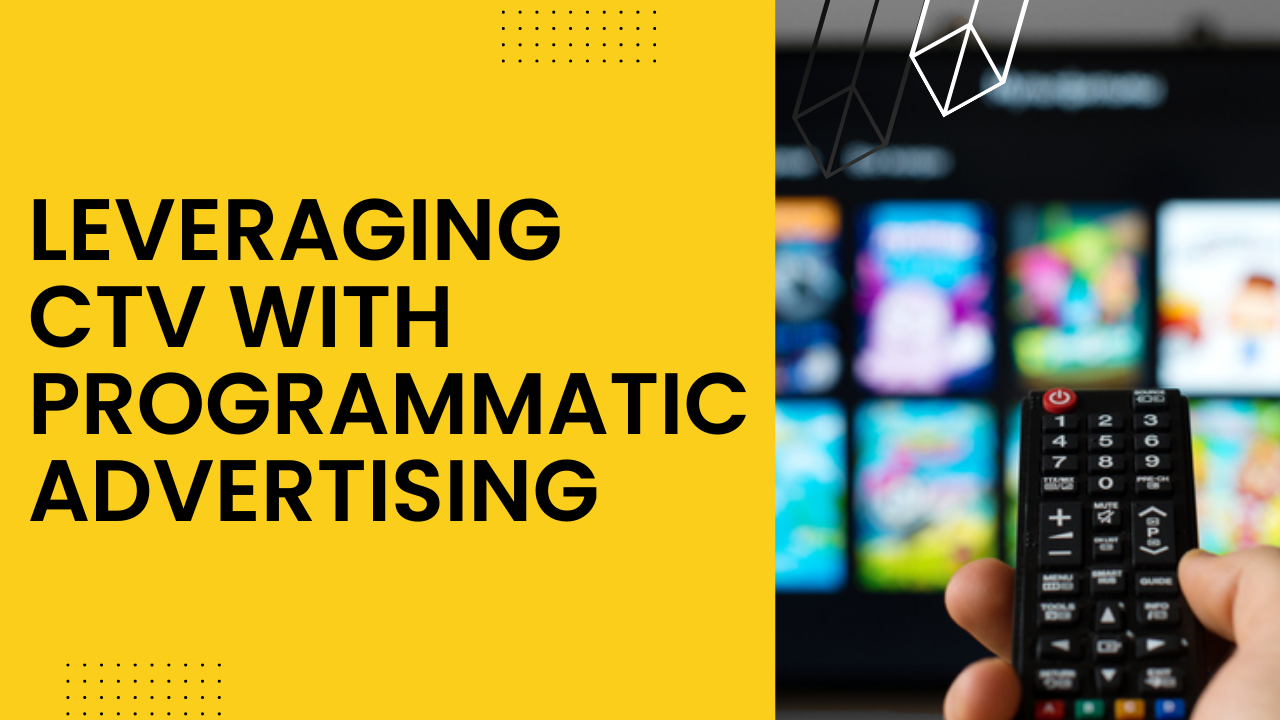CTV
is emerging as the next big thing in India which is transforming content consumption. Coupled with the rise in popularity of OTT platforms and the availability of native/local content, it’s clear that the CTV market is flourishing and if you’re a marketer, this is one of those opportunities that you do not want to miss.
ZEE5 India’s Chief Business Officer, Manish Kalra stated that ZEE5 has seen 3X growth in content viewing on CTV. “An important factor in the growth of CTV is that it is engineered to deliver an enhanced experience that supports the new age technologies that are now being used in film making. It lends itself to tech innovations on content display, delivery, and the viewing experience, which are critical aspects of the overall user experience,” Kalra added.
This offers a wide range of possibilities for marketers and advertisers. With the help of Programmatic Advertising, you can have much more control and flexibility. In this article, we will discuss everything related to CTV advertising.
1. CTV ecosystem in India:
CTV or Connected TV is a television that gets its content from the internet, rather than a cable network or DTH, which is available on demand.
During the pandemic, CTV viewership has skyrocketed. According to a recent report by FICCI-EY, the number of smart connected TVs will exceed 40 million by 2025
The increasing awareness and adoption of CTV have become a major vehicle for advertisers in India. CTV is slowly becoming an integrated household device. It has seen a 31% rise according to India CTV report. Research has shown that the smart TV share in the TV market soared to 84% in 2021 as compared to 67% in 2020.
Since CTV is new, the cost of advertising is low, as compared to traditional TV but the impact is equally high. As high-speed internet is becoming more accessible and internet-connected devices are becoming more and more popular, the CTV market is bound to grow with them.
In India, there are lots of brands that offer cheap smart TVs (as low as Rs 15,000) and there’s a very wide range of brands to choose from. This is propelling the popularity of CTV not just in tier-1 cities, but also in tier-2 and in some cases, tier-3 cities.
Also, India has the cheapest data costs in the world ($0.09 per GB) so the availability of internet-connected devices is rising rapidly. All of these above factors have made India the world’s fastest-growing OTT market, and with the accessibility of cheap Smart TVs and internet-connected devices, the Indian market is red hot right now.
2. Why advertising on CTV is gaining popularity in India?
Since the pandemic, people have been accepting the new normal. People are spending more time indoors and they are looking for ways to entertain themselves. There’s also a huge supply of local and native content, news, and music on OTT platforms. Today’s consumers have plenty of attractive options to choose from, unlike linear TV which is repetitive and monotonous.
CTV advertising offers unique advantages which were unthinkable in the time of traditional television. Let’s look at some of those unique advantages briefly-
- CTV offers better targeting options than traditional TV.
- CTV is highly measurable.
- CTV also allows advertising on different OTT content platforms.
- People can also access the internet and browsers via CTV, so ads can be shown there too.
- The user base of CTV is affluent and educated and they engage with the brands they like. The future content consumer is moving towards a more immersive viewing experience, so the opportunity to engage with them will be there.
- CTV content provides better brand recall and better storytelling capabilities due to attribution functionalities (more on this further).
- CTV provides better ad awareness and impact on purchase intent
- Research shows that the CTV video impressions were on par with mobile in 2020 and it’s likely to increase.
- CTV provides a larger consumer reach because of exclusive content and highly engaged audiences. Plus, it helps us in multi-targeting, meaning- if there’s a CTV in a household, then all the members will be using it. Unlike a phone or laptop which is usually used by a single person in the family.
- 66% of CTV users have subscriptions to more than one OTT app. As CTV rises, the demand for AVOD (Advertisement-based video-on-demand platforms) and SVOD (Subscription-based video-on-demand platforms) will also rise.
3. What is Programmatic Advertising?
We’ve talked about the popularity of CTV and its ecosystem in India. Now, let’s take a moment to understand what programmatic advertising is so that we can combine the functionality and flexibility of CTV with programmatic advertising to enhance the overall performance of your campaigns.
Programmatic advertising is the automated buying and selling of media with the help of Artificial intelligence and machine learning algorithms, as opposed to the traditional way of buying and selling media space that used to happen manually.
Programmatic advertising is data-driven and highly measurable. It gives marketers more control and visibility of consumer behavior. Cutting edge Advertising technology does the majority of hard work and leaves advertisers with the work that they really love- advertising.
Programmatic advertising allows advertisers to use first-party, and third-party data, and multiple ways of targeting so that the ads are delivered to the right person at the right time. You can access mobile, desktop, tablet, audio, digital outdoors, and connected TV using the Programmatic ecosystem. It is extremely cost-efficient and provides excellent targeting and measurement capabilities.
Here’s how Programmatic Advertising is taking over: In 2020, Programmatic Advertising accounted for 38% of the total advertising spend in India. The Southeast Asian advertising market is expected to register a CAGR of 15.29% during the forecast period 2021-2026. The Southeast Asian digital advertising market will grow strongly by $417.4 million in 2022. That’s modest compared to last year’s $555.7 million surges, but it’s sufficient to spend more than $4 billion this year.
With the rise of the success of programmatic advertising and CTV, there’s a massive opportunity for marketers and advertisers going forward. Not only, you can increase your reach and targeting, but you can also get more return on investment on your advertising spend.
The flexibility of CTV via Programmatic Advertising:
Benefits & Downsides of using Programmatic advertising via CTV
We have been talking on and on about the boom in CTV usage and how many amazing opportunities it can provide advertisers and marketers. Now, let’s take a moment to go a little deeper into the rabbit hole and look at a more detailed understanding of how effective CTV can be-
- People are using multiple devices simultaneously- mobile, CTV, Laptops, gaming consoles, etc. Advertisers can target them whenever and wherever they are and whatever they are using by programmatic advertising.
- CTV provides a user-controlled viewing experience, and it helps get your message in front of the right people at the right time. It can also give you more accurate data on user behavior and preferences, hence improving your targeting.
- User registration data enables cross-screen targeting across multiple devices via programmatic advertising.
- IP-based delivery allows the use of 1st party and 3rd party audience data to target homes using ad-supported OTT content (AVOD) and CTV devices.
- Ability to target relevant and selected publishers and placements.
- Ability to overlay 3rd party audience targeting on the inventory to narrow the targeting.
- Curated deals for premium placements like Star Sports during IPL etc.
- Ability to measure/attribute thus allowing us to optimize
- There’s a huge market that was previously not reached by traditional TV, but now with OTT and CTV advancements, you can reach them too
- Brand Safety – ads delivered during live TV or on-demand are reached across top-tier networks and popular content.
- Almost perfect ad completion- Viewers are watching ads all the way through with an average consumption rate of 98%.
- Retargeting OTT and CTV viewers- You can retarget OTT and CTV viewers across all devices that they might be using and generally most CTV users are using more than one device, like laptops, mobile, gaming consoles, etc.
The downside is that there could be minimum spends at some publisher’s levels. If an X amount of budget is set, there are chances that we underspend because of the programmatic nature of advertising.
How CTV advertisement provides a better Measurement and Attribution:
CTV advertisement is skippable online ads targeted to relevant content channels and audiences. CTV inventory is premium- professionally produced TV content. CTV advertising provides the following measurement capabilities:
- Video completion rate- the percentage of viewers who watch your ads till the end.
- Click- The number of clicks it took from your ad to your website
- Ad delivery by device- to which devices your ads were delivered to
- Performance by what time of the day it is
- Performance by specific days
- Ad viewer demographics
- Higher reach- the number of unique people that were reached by your ad
- Ad frequency- the average number of times you are delivering your ad to a given person
Attribution:
Marketing attribution is a tool used by advertisers and marketers to determine the effectiveness of marketing campaigns and get certain insights in particular. It allows you to figure out which user action led to a purchase; this way marketers can optimize their strategies to influence the buying decisions of their audience. Attribution has the following benefits:
- Spending optimization- By identifying the strong and weak points of their ads, the advertisers can adjust their budgets for a better ROI
- Better targeting- Attribution data helps the marketers to understand the consumer’s journey better and also know their preferences and needs
- Improves brand communication- It can help enhance the messaging delivered to the user
In order to understand how attribution can be utilized to hone your message and increase your performance, you need to know different kinds of attribution models:
- Single-touch attribution- First touch and last touch attribution models
- Multi-touch attribution model- This model plots the entire touchpoints of the user that led to a purchase and is the most accurate kind of attribution model. It includes several sub-models of attribution:
- Linear- equal credit is given to all touchpoints that led to a purchase
- U-shaped- first and the last touches that led to a purchaser are given the most credit
- W shaped- In addition to U shaped model, the opportunity point is added
- Time decay- touchpoints that are closer to the purchase are given more credit than others
*Sighs*
Take a deep breath in…You’ve come a long way.
You’ve just read a lot of new information. Our goal with this article was to announce to all the brands and marketers out there that you need to get into the CTV ecosystem and leverage the power of programmatic advertising!
With digital marketing, we never know what is the next big change in the landscape. So, it’s very difficult to adapt to a set of rules and regulations. CTV is that new change and you can bet on it.
We at Datawrkz, specialize in ad-tech. We talk, breathe, write, and eat all that is there to do with programmatic advertising and the cutting-edge ad-tech world. If you’re looking for someone to help you leverage your CTV ads with the help of Programmatic Advertising, we got you covered:
- Datawrkz’s enhanced programmatic capabilities-We have access to all leading programmatic DSPs who hold a vast network of CTV publishers.
- Datawrkz can help you in getting premium deals–We have our collaborations with a wide network of publishers to get you direct deals.
- Datawrkz can help you with advanced attribution and Second Screen Advertisements– with the help of our own CDP tech to capture ad viewers and attribute their online actions with relevant ads to leverage Second Screen Advertising










